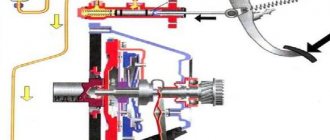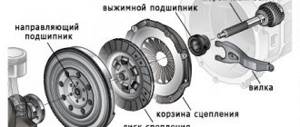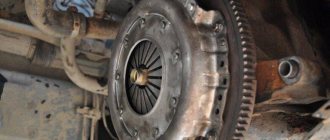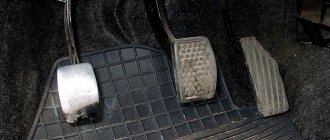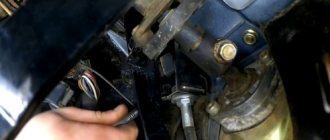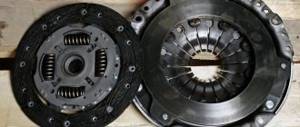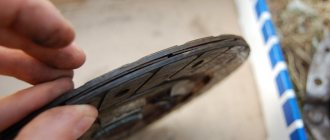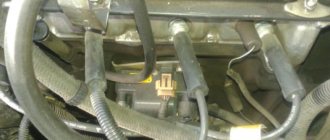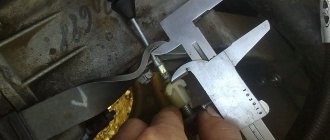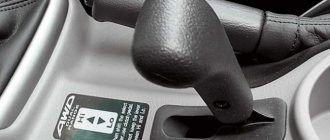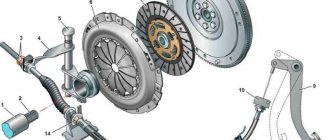What is a clutch cylinder?
The slave cylinder is a special device that directs excess pressure from the master cylinder to the clutch release fork. As a result, a control action is applied to the gearbox (gearbox) and switches to the appropriate engine operating mode.
Structurally, the clutch slave cylinder is very simple. This part consists of a metal body with an air release valve (fitting). A piston pusher with a spring is attached inside. The tightness of the device is achieved by installing several o-rings and a protective cover (its other name is better known - anther).
It will be difficult to notice, much less replace, this part simply by looking under the hood. The clutch slave cylinder is attached to the transmission housing. Therefore, inspection and repair are best performed in an inspection pit or on an overpass.
Working clutch cylinder for VAZ Classic, Niva
Dear customers, in order to avoid errors when sending the clutch slave cylinder, please indicate the model and year of manufacture of your car in the “Comment” line.
The main components in a hydraulic system are the cylinders. They are called the master and slave cylinders of the VAZ 2107 clutch.
The clutch slave cylinder is designed to ensure the transmission of force from the pedal to the release fork of the clutch mechanism, through the master cylinder rod to the slave cylinder, interconnected by a high-pressure tube.
1 - flywheel; 2 — clutch driven disc; 3 — clutch basket; 4 — release bearing with clutch; 5 — hydraulic clutch reservoir; 6 - hose; 7 — master cylinder of the hydraulic clutch release; 8 — servo spring of the clutch pedal; 9 — clutch pedal return spring; 10 — clutch pedal travel limit screw; 11 — clutch pedal; 12 — hydraulic clutch release pipeline; 13 — ball joint fork; 14 — clutch release fork; 15 — release spring for clutch release fork; 16 — hose; 17 — working cylinder of the hydraulic clutch release; 18 — clutch bleeder fitting
When you press the pedal, the master cylinder rod is activated, at the end of which there is a piston with an oil-gasoline-resistant cuff. The piston transmits pressure to the hydraulic fluid, thereby providing a force that is transmitted through the tube to the piston of the working cylinder. It converts hydraulic force into mechanical movement of the release fork, which in turn moves the release bearing, which presses the VAZ 2107 clutch disc.
1 - body; 2 - valve for bleeding the hydraulic clutch release drive; 3 — protective cover; 4 — clutch release fork pusher; 5 — piston sealing ring; 6 — piston of the working cylinder; 7 — piston cuff; 8 — bushing; 9 - spring; 10 — washer; 11- retaining ring.
The working cylinder is cast from fine-grained cast iron. It is secured to crankcase 2 with two bolts. The working cylinder body is bored to a diameter of 19.05 mm and a length of 70 mm. The inner surface of the cylinder (mirror) is processed with high precision, resulting in increased service life of the product. It is closed from the outside with a plug, which is installed on the gasket and tightened with a torque of 8-10 kgf*m. A fitting for supplying fluid to the cylinder is installed at the end of the plug. A chrome-plated steel piston is placed in the cylinder, the interface of which is sealed with a rubber ring, outer diameter 19.2 ± 0.15 mm and a cuff. The cylinder cuff is made of high quality rubber, which is resistant to environmental influences and aggressive chemicals. Tight pressing of the cuff to the cylinder mirror is ensured by the supply of pressurized fluid under the cuff through channels with a diameter of 2 mm. A tight fit of the cuff on the piston is ensured by installing a support plate supported by its own spring. The cylinder seal on the pusher side is ensured by installing a rubber protective boot on the end of the cylinder.
To ensure longevity and reliability of the cylinders, the pistons have a hard oxide coating that allows them to operate in excess of 1,000,000 cycles.
To release air from the cylinder when filling it with liquid or when pumping the hydraulic drive, the cylinder has a cone valve with a side hole with a diameter of 1.5 mm and a central channel with a diameter of 2.5 mm.
Technical characteristics of the clutch slave cylinder VAZ 2101 - 2107:
Working pressure: MPa – 20;
Cylinder diameter: mm – 19;
Piston stroke: mm - 36.
The hydraulic system uses only brake fluid of type DOT-3, 4, which has deep penetrating ability and does not corrode rubber O-rings.
Other articles of the product and its analogues in the catalogs: 2101-1602515-23, MB01-1602510, A11.1602510, P1944 C3.
Applicability: VAZ 2101, 2102, 2103, 2104, 2105, 2106, 21074, VAZ 2121, VAZ 2131, VAZ 2120.
Check the brake fluid level in the reservoir, especially before a long trip. Use only brake fluid. Wash away dust or wash the cylinders only with special cleaning liquids or, for example, methyl alcohol, but in no case with gasoline or oil.
Any breakdown is not the end of the world, but a completely solvable problem!
How to independently replace the clutch cylinder on a VAZ 2101-2107 family car.
AvtoAzbuka online store, repair costs will be minimal.
Just COMPARE and BE SURE!!!
Don't forget to share the information you find with your friends and acquaintances, because they may also need it - just click one of the social networking buttons located above.
How to determine the malfunction?
In general, problems with the clutch are indicated by:
- pedal failure or too soft movement;
- difficulties when changing gears (for example, the required gear can only be engaged by repeatedly pressing the clutch pedal);
- excessive consumption of clutch fluid.
Some problems may require complete replacement of the clutch slave cylinder. But most often its malfunction lies in the wear of the o-rings. This can be detected by fluid leakage.
You can also find out if the clutch system is leaking by bleeding the hydraulic drive. This operation is easy to carry out, but you cannot do it alone; you will need the assistance of an assistant.
If you need to replace the entire cylinder, it’s okay: a new part, depending on the make of the car, costs between 300-600 rubles - a very affordable price. The cylinder is working, the clutch is functioning - what the driver needs at a low cost.
Checking the tightness of the system
To carry out this operation, you must complete several steps:
- Before pumping begins, the missing volume of liquid is added.
- Next, take a small hose (half a meter will be more than enough), one end of it is connected to the fitting of the working cylinder, and the other is lowered into a transparent container (you can take a large-capacity plastic bottle).
- Then you need to ask the assistant to press the clutch pedal five times (you need to press it sharply, the interval between presses is about three seconds, at the last you need to leave the pedal pressed).
- Then the fitting is loosened with a wrench. Brake fluid will begin to flow into the container, containing air bubbles.
- When the reservoir is approximately three-quarters empty, the outlet valve closes.
- The brake fluid is added again, the operation is repeated several times and stops only when the air bubbles stop flowing. If this does not happen even after the 3-4th cycle, it means the clutch system is leaking.
How to bleed the clutch
Removing air from the system is necessary after any repair of the central circulation system. It is better to carry out work with an assistant. Bleeding the VAZ-2107 clutch cylinder is carried out in the following sequence:
- prepare a small diameter hose and a container with brake fluid;
- fill the tank without adding 1.5 - 2 cm to the top;
- “release” the working cylinder fitting a little and put the hose on it;
- lower its second end into a container with brake fluid;
- press and release the clutch pedal until all the air is released from the system, this can be determined by the absence of bubbles;
- as soon as this happens, you need to fix the pedal pressed and tighten the fitting;
- check clutch operation.
If necessary, the process should be repeated.
If the cylinder is faulty
Domestic cars are famous for their ease of repair. Replacing or repairing the VAZ clutch slave cylinder yourself is also not difficult.
This part is designed very simply, so it rarely fails entirely. However, the O-rings, unfortunately, are made of low quality rubber, which cannot but affect the durability of the work. Therefore, usually, in order to restore functionality, it is enough to buy a special repair kit for the clutch slave cylinder.
It is very cheap: depending on the manufacturer and store, about 100-200 rubles. You can also buy suitable oil seals and boot separately. In this case, the costs will not exceed a couple of tens of rubles.
When the slave cylinder is installed after repair, you should fill in the fluid and pump, while simultaneously flushing, the clutch system. This is done in the same way as pumping, but the liquid is drained until it becomes completely transparent and without air bubbles.
Selection of GVC for VAZ 2107
The best option for replacement is to purchase a GCS designed specifically for classic VAZ models. Clutch master cylinders from UAZ, GAZ and AZLK vehicles are not suitable. The same applies to foreign analogues - foreign cars with rear-wheel drive are equipped with GVCs, which only highly qualified specialists can adapt to the VAZ 2107 (different sizes, different threads for pipelines, different pipe configurations). However, you can easily replace the original cylinder with a GCS from a VAZ 2121 and from a Niva-Chevrolet.
Manufacturer's choice
When purchasing a new GVC, you should focus on products from trusted Russian manufacturers (AvtoVAZ JSC, Brik LLC, Kedr LLC), the Belarusian company Fenox, which is adapted to our conditions and is affordable. The average cost of GVC is 600–800 rubles.
Removing and disassembling the cylinder
Before you start work, it’s worth preparing a small box where the removed parts will be stored later - this way there’s less danger of losing something.
To repair the working cylinder, it must be removed. This is done as follows:
- the nut securing the hydraulic drive hose is loosened;
- the tension spring is removed;
- the pin on the pusher is removed;
- the cylinder is attached to the gearbox housing using two screws that need to be unscrewed;
- the mounting bracket is removed;
- the cylinder is removed from the clutch fork;
- The hydraulic drive fastening nut is completely unscrewed. After this, clutch fluid will begin to pour out of the hose - you need to wait until it completely flows into the substituted container.
The next step is to disassemble the clutch slave cylinder:
- the exhaust valve opens;
- the protective cover is removed (you can pick it up with a screwdriver) and the pusher;
- a thin object pushes the piston out;
- the spring is removed from the piston, and then the sealing rings;
- Clean the valve and cylinder bores.
Repairing the clutch cylinder
After disassembly is complete, you must:
- Prepare the clutch slave cylinder repair kit for operation.
- Wash all elements of the working cylinder in clean brake fluid (using other means, for example, solvent, acetone, gasoline, kerosene is not recommended) and inspect.
- If the O-rings and protective cover are worn out or have lost their elasticity, they must be replaced with parts from the repair kit..
- Instead of a failed spring, you can install a part of a similar length, diameter and stiffness.
- However, if damage to the piston, pusher, fitting or housing is discovered, a complete replacement of the clutch slave cylinder is inevitable. It will be difficult to buy these parts separately. But you can take whole parts of another working cylinder.
- After replacing the parts, the cylinder is assembled and installed in place. In this case, you need to follow the reverse order to the previously given one.
- Check the tightness of the system as described above.
Upon completion of all work, you need to check the clutch system. The pedal should be pressed smoothly, and gears should be changed easily the first time.
Overhaul and repair of the main brake cylinder
Removal and installation of the master cylinder occurs according to the classical scheme - I remember how I removed it in order to put it back in the same order. There is no point in describing this process in detail.
Disassembling the master cylinder is not recommended for those who have no plumbing skills at all. Then it is easier to replace the master cylinder assembly.
After disassembly, we proceed to washing the cylinder parts. Flushing is carried out only with brake fluid. It is advisable to change all the parts that are in the repair kit, especially the O-rings and the return spring.
When inspecting the cylinder, pay special attention to: the condition of the body, the condition of the mirror and the rod. Minor corrosion or slight scuffing can be removed with a fine-grit sanding block. Although scuffing may indicate a violation of the clearance between the piston and cylinder.

